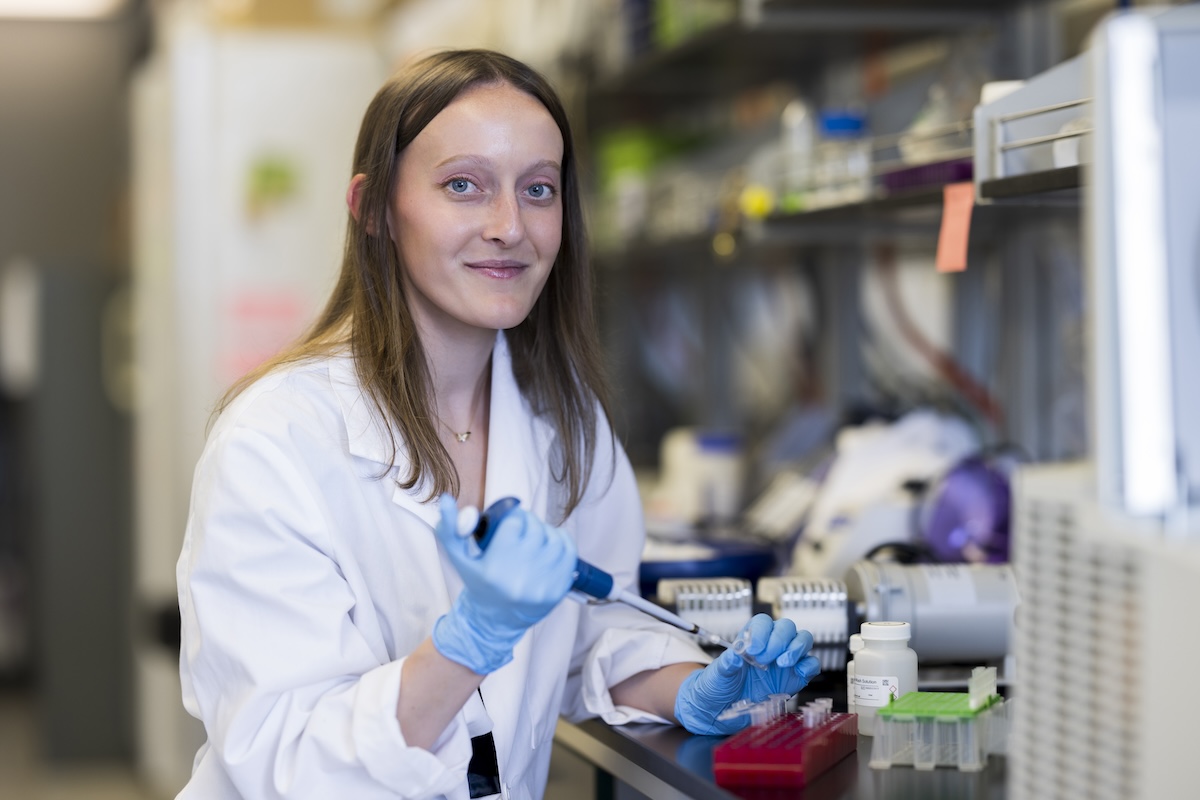Winner of Three Minute Thesis competition explores biofilms
Emma Glynn’s presentation placed first in the judged competition while improving her science communication skills

How long would it take to describe one of the most complicated scientific concepts you know? Each year, some Binghamton graduate students whittle down their answer to a mere three minutes.
“Everyone should have access to research that scientists are doing,” said Emma Glynn, a doctoral student in biological sciences and the winner of Binghamton University’s fifth-annual Three Minute Thesis event. “Everyone should be able to understand the implications of the research. It’s important to make things digestible for people, and I think by finding topics that people are passionate about and comparing them to your own research, you can make connections that allow people to understand this complex research a little bit better.”
Three Minute Thesis, abbreviated as 3MT, originated in Queensland, Australia, in 2008. Allan Lawson, an emeritus professor and dean of the Graduate School at the University of Queensland, thought up the idea to improve science communication during a drought when citizens were asked to limit showers to three minutes to conserve water. While only 160 students contributed to the first competition, today more than 900 universities in 85 countries put forth participants to share their research. This year, Binghamton University had 13 presenters.
Glynn’s presentation, titled “Bacterial ‘Bodybuilders’ Rely on Protein to Stay Big and Strong Too!” focuses on biofilms, and likens these amalgamations of bacteria — more common in nature than singular planktonic bacteria — to bodybuilders. Proteins keep both biofilms and bodybuilders running, although in a biofilm, the proteins help the organism remain naturally resistant to antibiotics, rather than gain muscle.
“I work with biofilms: essentially, these big, sticky, slimy conglomerates of bacteria that attach to surfaces,” Glynn said. “They’re problematic regarding catheters and surgical implants; biofilm-associated infections are responsible for a large majority of hospital-acquired infections, and they even pose a significant issue in industries that deal in your drains and bathtubs. Globally, they’re responsible for hundreds of thousands of deaths in the U.S. each year.”
The 3MT competition challenges graduate students to present their research to a non-specialist audience using only a single, static PowerPoint slide. The judges select the most successful presentation to convey the excitement and innovation of research, using the criteria of content, comprehension, communication and engagement.
Glynn’s presentation was selected for first place by a panel of research communicators, and it also won the “People’s Choice” prize after audience members voted.
“Emma’s 3MT presentation elegantly explained a complicated research project about a niche area of science,” said Kevin Boettcher, research development specialist for the Office of Strategic Research Initiatives, who served on the judge’s panel. “The other judges and I were particularly impressed by her easy, engaging style up on stage. Emma really communicated her joy and enthusiasm in the work that she does, in both the verbal and visual parts of the presentation.”
In second place was Emma Pawliczak, a mechanical engineering student whose presentation was titled “Silver Spray: Shielding Electronics While Keeping Them Slim.” “Climate, War, and Economic Crisis — Lessons from Early Modernity,” presented by John Antonacci, a sociology student, placed third.
Glynn has been involved with biofilm research since her undergraduate days. When she first came to Binghamton, she joined the First-year Research Immersion (FRI) program, which has an entire stream focusing on the topic. From there, she began to work in the lab of Karin Sauer, a distinguished professor of biological sciences, who later became her graduate advisor.
In a lab with several other researchers, Glynn focuses on the bacteria Pseudomonas aeruginosa, and the protein-protein interactions that keep them tolerant to antibiotics, and the team hopes to find a way to disrupt this process or have it work in our favor.
“Some of our research aims to determine if we can disrupt these interactions between proteins and if that results in lowered antibiotic resistance and smaller, weaker biofilms,” Glynn said. “Some protein-protein interactions have been substantiated as good targets for cancer therapies. Also, these proteins can act as antioxidants, working to remove toxins from the environment.”
While she still has a few years to go while she completes her doctoral work, Glynn is already looking to the future. While carving a path through academia, she has found a particular interest in teaching and mentoring — both to new undergraduate lab members attending Binghamton University and those from other institutions as part of the Research Experience for Undergraduates (REU) program.
“We have some students come and work in the lab for 10 weeks over the summer,” she said. “I want to continue to teach and mentor students because it’s very fulfilling; I like to make students feel they are worthy and capable.”
In addition to helping her with her science communication skills, 3MT also provided her with a chance to take her research abroad.
“With the money that I won from the Three Minute Thesis competition, I want to go to an international pseudomonas conference, in Copenhagen, Denmark, in the fall, and present this research,” she said. “It’s a very renowned conference, that only happens every two years. I’ve already applied, and I’m so excited to even have the opportunity!”
Glynn is thankful for Binghamton’s resources but says that students must also make sure to engage whenever they can. She urges individuals to strike up a research conversation with their professors, as well as other students, and get involved with opportunities in the sciences, the arts or the humanities, regardless of their focus.
“If you can come up with a way to combine your love of your research with another passion that you have, it’s an effective way to get your research and your findings across,” she said. “And have fun with it! That’s what I do — and I always enjoy the whole process.”
